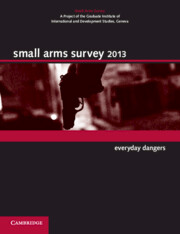Book contents
- Frontmatter
- Foreword
- Contents
- About the Small Arms Survey
- Notes to readers
- Acknowledgements
- Introduction
- Chapter 1 Everyday Dangers: Non-conflict Armed Violence
- Chapter 2 Too Close to Home: Guns and Intimate Partner Violence
- Chapter 3 Turning Points: Gang Evolution in Nicaragua
- Chapter 4 Guns in the Family: Mafia Violence in Italy
- Chapter 5 Survival at Stake: Violent Land Conflict in Africa
- Chapter 6 Trend Lines: Armed Violence in South Africa pages 132 to 137
- Chapter 6 Trend Lines: Armed Violence in South Africa pages 137 to 159
- Chapter 7 Second Wind: The PoA's 2012 Review Conference pages 160 to 168
- Chapter 7 Second Wind: The PoA's 2012 Review Conference pages 169 to 177
- Chapter 8 Trade Update: Authorized Small Arms Transfers
- Chapter 9 Burning the Bullet: Industrial Demilitarization of Ammunition pages 186 to 199
- Chapter 9 Burning the Bullet: Industrial Demilitarization of Ammunition pages 200 to 217
- Chapter 10 ‘Infernal Machines’: Improvised Explosive Devices
- Chapter 11 Price Watch: Arms and Ammunition at Illicit Markets pages 250 to 268
- Chapter 11 Price Watch: Arms and Ammunition at Illicit Markets pages 269 to 281
- Chapter 12 Captured and Counted: Illicit Weapons in Mexico and the Philippines pages 282 to 302
- Chapter 12 Captured and Counted: Illicit Weapons in Mexico and the Philippines pages 302 to 317
- Index
Chapter 3 - Turning Points: Gang Evolution in Nicaragua
Published online by Cambridge University Press: 05 June 2014
- Frontmatter
- Foreword
- Contents
- About the Small Arms Survey
- Notes to readers
- Acknowledgements
- Introduction
- Chapter 1 Everyday Dangers: Non-conflict Armed Violence
- Chapter 2 Too Close to Home: Guns and Intimate Partner Violence
- Chapter 3 Turning Points: Gang Evolution in Nicaragua
- Chapter 4 Guns in the Family: Mafia Violence in Italy
- Chapter 5 Survival at Stake: Violent Land Conflict in Africa
- Chapter 6 Trend Lines: Armed Violence in South Africa pages 132 to 137
- Chapter 6 Trend Lines: Armed Violence in South Africa pages 137 to 159
- Chapter 7 Second Wind: The PoA's 2012 Review Conference pages 160 to 168
- Chapter 7 Second Wind: The PoA's 2012 Review Conference pages 169 to 177
- Chapter 8 Trade Update: Authorized Small Arms Transfers
- Chapter 9 Burning the Bullet: Industrial Demilitarization of Ammunition pages 186 to 199
- Chapter 9 Burning the Bullet: Industrial Demilitarization of Ammunition pages 200 to 217
- Chapter 10 ‘Infernal Machines’: Improvised Explosive Devices
- Chapter 11 Price Watch: Arms and Ammunition at Illicit Markets pages 250 to 268
- Chapter 11 Price Watch: Arms and Ammunition at Illicit Markets pages 269 to 281
- Chapter 12 Captured and Counted: Illicit Weapons in Mexico and the Philippines pages 282 to 302
- Chapter 12 Captured and Counted: Illicit Weapons in Mexico and the Philippines pages 302 to 317
- Index
Summary
INTRODUCTION
Gangs are widely considered to be among the most important security threats in post-cold war Central America, to the extent that they have been characterized as a ‘new urban insurgency’ aiming ‘to depose or control the governments of targeted countries’ (Manwaring, 2005, p. 2). As a result, policy-makers and the general public see them as a danger that has the potential to extend beyond the region, in particular to the United States and Canada. At the same time, however, branding gangs a ‘national security threat’ or a ‘new urban insurgency’ can significantly distort our understanding of the phenomenon (Hagedorn, 2008, p. xxx). The topic of gangs is often sensationalized, whether in media reports, academic studies, or policy documents, and the overwhelming majority of available information on Central American gangs is arguably flawed, with official statistics particularly inconsistent ‘due to institutional weaknesses, deficient data collection, and the discretionary if not political use of crime data’ (Wolf, 2012, p. 68).
Central American gangs are furthermore often considered generically, when it is critical to distinguish between the very different phenomena of pandillas and maras. The former are localized, home-grown gangs, while the latter are a hybrid social form with transnational roots. Pandillas were initially present throughout the Central American region in the post-cold war period but have been largely supplanted by maras in El Salvador, Guatemala, and Honduras; today, they are only significantly present in Nicaragua.
- Type
- Chapter
- Information
- Small Arms Survey 2013Everyday Dangers, pp. 46 - 73Publisher: Cambridge University PressPrint publication year: 2013

